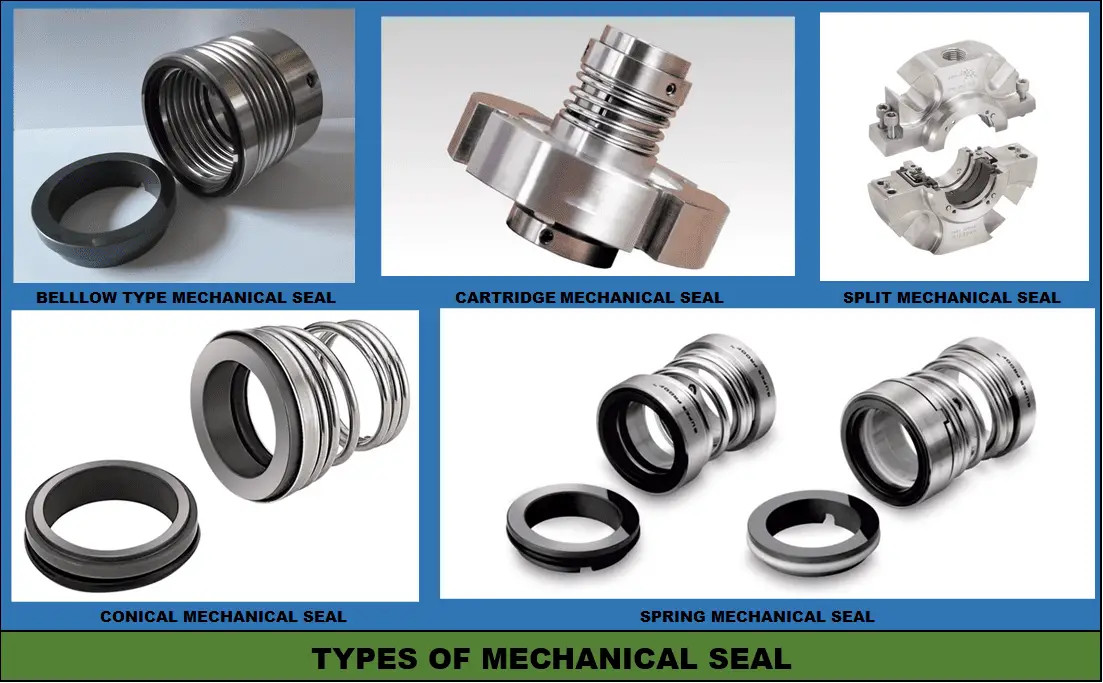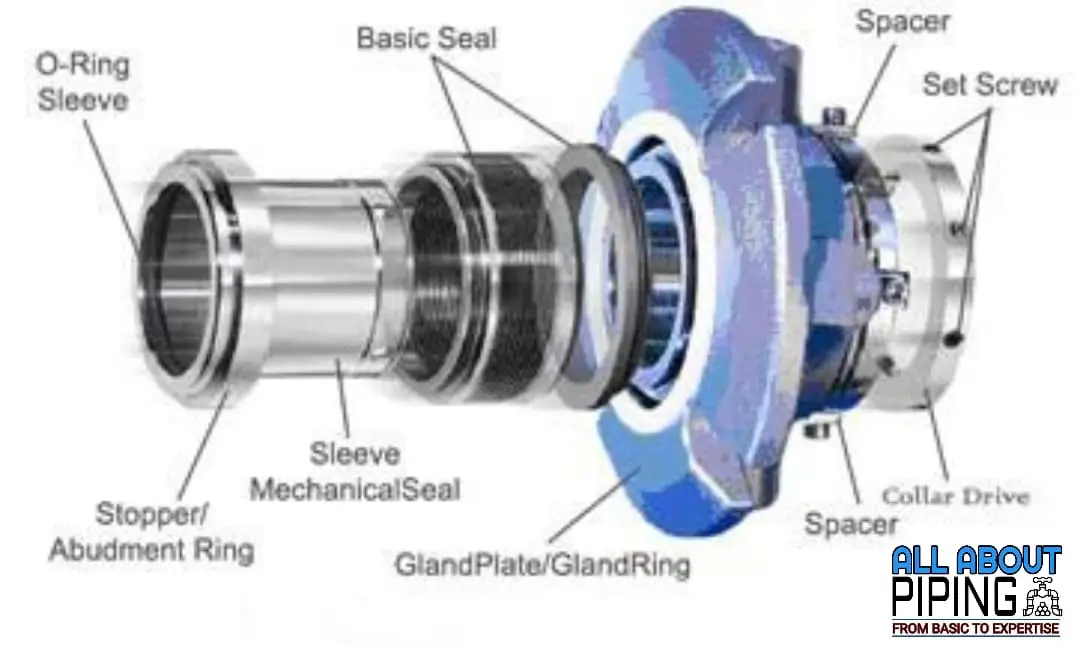Ever wondered how those big machines that keep our industries humming smoothly manage to contain all the liquids they deal with? Well, that’s where, the mechanical seals, come into play. Picture them as the guardians of pumps, making sure nothing leaks, and everything runs like clockwork.
Mechanical seals play a crucial role in preventing fluid leakage and ensuring the efficient operation of various industrial pumps. Understanding the different seal types and their applications is essential for maintaining optimal performance and extending the lifespan of pumps. In this article, we will delve into the diverse world of mechanical seals, exploring the various types and their specific applications. Basics of Mechanical Seal
Table of Contents
What is Mechanical Seal?
A mechanical seal is a device used to prevent fluid leakage in rotating equipment, such as pumps and compressors. Its primary function is to seal the gap between the rotating shaft and the stationary pump or compressor casing, preventing the escape of liquids or gases from the system. Essentially, a mechanical seal acts as a barrier, ensuring that the internal fluids stay where they belong and don’t leak into the surrounding environment.
These seals are critical components in various industrial applications, ranging from water pumps and chemical processing equipment to oil refineries and power plants. They help maintain the efficiency and reliability of machinery by preventing leaks and minimizing the risk of contamination or environmental hazards. Mechanical seals typically consist of rotating and stationary components that create a secure seal when pressed together, often using springs or other mechanisms to maintain consistent pressure.
More Resources: Type and Selection of Hydraulic Oil
Why Mechanical Seals Popular in Modern Engineering?
Mechanical seals are extensively utilized due to their superior ability to prevent fluid leakage compared to alternative methods. They effectively seal the rotating shaft against the stationary component in pumps and other mechanical devices.
A variety of mechanical seals is available, and the selection is contingent upon the specific functionality and application requirements. Engineers carefully assess functional needs and operating conditions to choose the most suitable type for the task at hand.
Components of Mechanical Seal
A mechanical seal consists of several essential components that work together to create a secure barrier against fluid leakage in rotating equipment. The key components include:
- Rotating Face or Rotary Seal: This is the part of the mechanical seal that rotates with the shaft of the equipment. It is in direct contact with the fluid being sealed.
- Stationary Face or Stationary Seal: The stationary face remains fixed in place, creating a sealing interface with the rotating face. It is typically housed in the pump or compressor casing.
- Secondary Sealing Elements: These are additional components, such as O-rings or elastomeric elements, that provide secondary sealing and enhance the overall effectiveness of the mechanical seal.
- Springs: Springs are used to maintain a consistent force between the rotating and stationary faces. They help ensure proper contact and sealing even as the equipment experiences variations in operating conditions.
- Metal Bellows or Diaphragm: In certain types of mechanical seals, a metal bellows or diaphragm is employed to accommodate axial and radial movement of the shaft while maintaining a seal.
- Gland and Gland Plate: The gland is the housing that contains and supports the mechanical seal. The gland plate helps secure the stationary face in place.
- Set Screws or Fasteners: Set screws or fasteners are used to secure the mechanical seal in its housing, ensuring it stays in the correct position during operation.
Understanding how these components work together is crucial for the proper installation, maintenance, and performance of mechanical seals in various industrial applications. Regular inspection and maintenance help extend the lifespan of the seals and contribute to the overall reliability of the equipment.
More Resources: Falling film evaporator: Design, Working, Features and Application
How Mechanical Seal Works?
A mechanical seal works by creating a barrier between the rotating and stationary components of a pump or other rotating equipment to prevent the leakage of fluids. The seal operates at the point where the rotating shaft of the equipment passes through the stationary pump or compressor casing. Here’s a step-by-step explanation of how a mechanical seal works:
- The mechanical seal consists of two main components: a rotating face and a stationary face. The rotating face is attached to the shaft and rotates with it, while the stationary face is fixed creating a contact surface within the pump or compressor casing.
- The rotating and stationary faces come into contact, creating a sealing interface. These faces are often made of materials like carbon, ceramic, or a combination of materials, depending on the application.
- Springs or other mechanisms are used to apply a controlled force between the rotating and stationary faces. This force ensures continuous contact between the faces, maintaining an effective seal.
- As the equipment operates, the mechanical seal prevents the escape of fluids (liquid or gas) from the system. The interface between the rotating and stationary faces acts as a barrier, containing the fluid within the pump or compressor.
- Additional components, such as O-rings or elastomeric elements, provide secondary sealing to enhance the effectiveness of the mechanical seal. These elements help compensate for any minor misalignments or variations in operating conditions.
Some mechanical seals have provisions for fluid circulation between the sealing faces to provide cooling and lubrication. This helps dissipate heat generated during operation and ensures smooth rotation. In cases where the shaft undergoes axial or radial movement, a metal bellows or diaphragm may be used to accommodate these movements while maintaining an effective seal.
Types of Mechanical Seal

Mechanical seals come in various types, each designed to meet specific operational requirements and conditions. Here are some common types of mechanical seals:
Spring Mechanical Seals
Spring seals are known for their simplicity and cost-effectiveness. They find applications in systems with lower pressure and temperature requirements, making them suitable for various light-duty tasks.
Single-spring and Multi-spring mechanical are 02 kinds of Spring mechanical seals, While single springs mechanical seals are simple and cost-effective Multi-spring mechanical seals provide enhanced reliability and adaptability for a diverse range of applications.
Cartridge Mechanical Seals
Cartridge seals come pre-assembled, simplifying the replacement process. Their compact and easy-to-install design makes them a preferred choice in industries where quick and efficient maintenance is crucial.
Split Mechanical Seals
Designed for easy retrofitting without the need for complete disassembly, split seals are practical solutions for pumps operating in confined spaces or challenging installation environments.
Bellows Mechanical Seals
Metal bellows seals are well-suited where flexibility is required in operation. For applications involving high temperatures, aggressive chemicals, and corrosive fluids metal bellow seals are being used. They are commonly used in chemical processing, petrochemical, and refinery industries. Where elastomeric bellows are used for high flexibility, these seals can adapt to axial and radial shaft movement. They are ideal for pumps with dynamic axial and radial shaft movements.
Conical Spring Mechanical Seals
Featuring a conical spring design, these seals provide improved stability and reliability. They are suitable for applications with moderate to high pressures and temperatures.
Importance of Mechanical seal
A mechanical seal serves as a barrier to prevent the escape of fluids into the external environment by sealing the rotating part against the stationary one. Experts highly commend mechanical seals for several reasons:
- Minimal Leakage: Mechanical seals achieve nearly zero leakage, making them particularly well-suited for processes involving harsh chemicals such as HCL or Sulfuric Acid, as well as toxic compounds. Some controlled leakage is necessary for lubrication purposes.
- Enhanced Pump Throughput: The implementation of mechanical seals results in low frictional drag, leading to improved pump throughput. Additionally, there is a significant reduction in power consumption.
- Increased Longevity: The mechanical components, including sleeves and shafts, exhibit prolonged durability, minimizing the rate of wear and tear.
- Reduced Preventive Maintenance: Properly installed mechanical seals diminish the need for frequent preventive maintenance. Their robust and enduring nature contributes to extended operational reliability.
- Capability for High Speeds and Pressure: Mechanical seals can withstand higher speeds and pressures compared to conventional packing methods.
- Wide Design Spectrum: Mechanical seals are available in a diverse range of design specifications, catering to various types of pumps and machinery. This versatility allows for compatibility with a broad spectrum of applications.
Selection of Mechanical Seal Types
Choosing the correct mechanical seal is very important for the smooth running of rotating equipment. The below table may help with the selection of a mechanical seal.
| Selection Criteria | Single/Multi-Spring | Cartridge | Split | Metal/Elastomer Bellows | Component | Conical Spring |
|---|---|---|---|---|---|---|
| Operating Conditions | Y | Y | Y | Y | Y | Y |
| Fluid Compatibility | Y | Y | Y | Y | Y | Y |
| Equipment Type | Y | Y | Y | Y | Y | Y |
| Industry Standards | Y | Y | Y | Y | Y | Y |
| Abrasion and Wear Resistance | Y | Y | Y | Y | Y | |
| Direction of Rotation | Y | Y | Y | Y | Y | Y |
| Ease of Installation | Y | Y | Y | Y | ||
| Maintenance | Y | Y | Y | Y | ||
| Budget Considerations | Y | Y | Y | Y | Y | Y |
| System Contaminants | Y | Y | Y | Y | Y | Y |
| Shaft Movement | Y | Y | Y | |||
| Vendor Reputation | Y | Y | Y | Y | Y | Y |
Conclusion
The mechanical seal has completely replaced traditional methods due to its undeniable superiority.
It demonstrates resilience under challenging operating conditions, including high temperatures, pressures, and exposure to toxic or corrosive fluids, ensuring an elevated level of safety.
Adopting this mechanism not only promises the prevention of fatalities, accidents, and environmental damage but also earns approval from operation engineers to the maintenance department. Bid farewell to downtime caused by wear and tear or leaks, accompanied by substantial savings on operational costs.
However, it is imperative to seek expert advice before making the switch. Ensuring that the investment aligns with your specific needs is crucial for a seamless transition.

